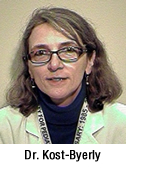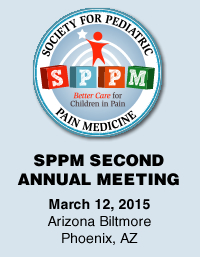president's message
Great Beginnings
 By Sabine Kost-Byerly, MD
By Sabine Kost-Byerly, MD
The Johns Hopkins Hospital
Baltimore, MD
As I begin my term as SPPM president, I am honored to serve and humbled to work with the outstanding group of individuals elected to the first full Board of Directors of the Society. The opportunities I have had to collaborate with many of you during the process of creating this Society, have affirmed my belief that we have the expertise, the dedication, and the passion to make a difference in the lives of children afflicted by painful conditions. Although the Society now has an Executive Committee and a Board of Directors, I would like to invite you, better yet, I expect all of you to fully participate in your Society. Awareness of the nuances of our practices will help us to understand how we can best serve pediatric patients and their families in both tertiary academic medical centers AND in private practice office settings. I suspect we have neither found the perfect prescription for a teenage wisdom tooth extraction nor for a limb salvage procedure. Thus, I invite you to share your expertise with others in the Society’s developing committees at the 2nd Annual Meeting at the Arizona Biltmore in Phoenix on March 12, 2015.
This year’s program will begin with food for thought, an intriguing examination of the interactions between sleep, pain and analgesia. Acute and persistent pains make for poor sleep but do analgesics let you rest easier? Three well-known experts representing the multi-disciplinary nature of pediatric pain management will surely enlighten us. Transitioning to the clinical science sections we will examine the controversial topic of monitoring analgesic delivery. How do we keep it safe? Is there a standard of care? Is it changing? Can we trust the available equipment? I am really looking forward to a lively discussion. A session on palliative care could increase your armamentarium for the next difficult consultation, especially if palliative care is not part of your everyday practice. Finally, regional anesthesia aficionados do not despair; you are not to be forgotten, as the entire program is sprinkled with information on how to enhance your practice. Dr. Robert Wilder has done a fabulous job putting this program together. I sincerely hope you will be joining us in Phoenix.
Looking towards the future, a young organization such as ours is dependent on active participation of its members. Beyond attending the Annual Meeting to gain new insight into your specialty or to network with like-minded professionals, I invite you to play an active part in your Society. The immediate needs will be the further development of the Society’s committees and preparations for the 3rd Annual Meeting in 2016.
The communications committee is responsible for the publication of this newsletter, the development of the Society’s website, as well as social media communication. If you would like to write an article, a case discussion, or have an eye for new web developments please contact the committee chair, Dr. Irfan Suleman. Let those creative juices flow. Research and QA and safety are other just forming committees. So, look for your Society leaders at the Annual Meeting and learn how you can become involved.
The 3rd Annual Meeting in 2016 will greatly depend on feedback we receive from your evaluations in Phoenix. If there were particular topics, workshops, or speakers you feel would contribute to the Society’s mission and would be of benefit to its members, please add it to your evaluation or send an email to Dr. Anjana Kundu, the Chair of the education committee or to Dr. Yuan-Chi Lin, the Chair of the 2016 Annual Meeting. A Co-chair, still to be selected, will support him and automatically become the Chair for the 2017 Annual Meeting. Should you be interested in nominating someone or yourself for this position, please let me know.
Finally, sharing experiences from a variety of practices and communities will help us to better understand our patients’ needs, barriers to care and available resources. Integrating this information with new research and quality improvement initiatives will allow us to develop new approaches to the complex needs of children with painful health conditions wherever they reside. It’s a great opportunity to make a difference. Thank you for allowing me to be part of this initiative.

